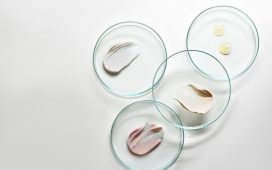Rome is quiet. Tourists are keeping away and Romans, pragmatic by nature, are lying low. If, as I did, you happen to find yourself at the Sistine Chapel, it isn’t just the ceiling that is a marvel, but the fact that you can see every single tile on the mosaic floor. Being well-stocked with pasta and hand gel is a way of life here already, so little change there. The men selling garlic at the market are more in demand than usual, and children are diligently counting to 20 while they wash their hands and doing the dab when they sneeze. Schools and universities are now closed for 15 days – a precaution for Lent.
Also in the Vatican, I saw various portraits of Pope Gregory, the great architect, circa 600AD, of the eventual split between the patriarchs of Constantinople and the bishop of Rome. Elisabeth Luard writes in her exceptional book, Seasonal European Dishes, that it was Gregory who decreed Lent to be a total fast until sundown, with no meat or dairy products to be taken during the 40-day fasting period. Later popes were more or less strict according to the period.
At some point in the Middle Ages, Roman breads and small loaves, sweetened with honey and dried fruit, evolved into quaresimali (almond biscuits for Lent). Restrained enough to be considered a Lenten abstinence (no animal fat and not too sweet), quaresimali were – according to the Roman writer Livio Jannattoni – good enough “to satisfy greed without putting you in a position of sin”. Maritozzi – today’s recipe – is an 18th-century name for a variant of quaresimali, split and filled with cream, which according to legend was given to girls by suitors to ensure they became their marito (husband).
At this time of year, bakers and bars sell both quaresimali and maritozzi, the latter usually without the addition of dried fruit and almost always with cream. Rather than giving up, I take things up for Lent, and these are two of my favourites, to buy at a bakery, eat standing up at a bar with coffee, and to make at home. This recipe is partly that of Carla Tomasi, partly my friend Dan Etherington’s, and is a reliable and satisfying one.
One of the things I miss in Rome is good cream. While you can find cream, it is rarely something to get excited about: it whips, but only just, and lacks substance and flavour. Not that this stops me buying it to fill maritozzi or to top gelato, where its just-about-bearable lightness is just right. Lucky are those of you who can find cream that whips into velvet folds. Split the buns lengthways, open them up as if they were doing the splits and, using a spatula, spread thickly with cream. Eat for breakfast.
Maritozzi
You can make the dough in a processor with a dough hook, or by hand, mixing and kneading it until you have a slightly tacky but silky and smooth dough.
Prep/rise 2 hr 30 min
Cook 15 min
Makes 12-15
For the sponge
50g bread flour (manitoba)
20g caster sugar
1 tsp (10g) fast-action dry yeast or 20g fresh yeast
250ml lukewarm milk (or water for a vegan version)
For the main dough
240g bread flour
120g “00” flour
50g caster sugar
The zest of half a lemon
40g sultanas/pine nuts/candied peel, or a mix of the three (optional)
A pinch of fine salt
60g olive oil
1 egg yolk
For the glaze
50ml water
50g sugar
Heat the oven to 200C (180C fan) gas 6. For the sponge, mix the flour, sugar and yeast in a bowl and add water. Stir well, then leave for 15-20 minutes, or until the sponge is bubbling.
Mix all the dry dough ingredients, add them to the sponge, add the oil and egg yolk, and knead until silky smooth.
Put it back in a clean, oiled bowl and leave to rise for two hours, by which time it should have doubled in size. Tip it out of the bowl on to to a lightly oiled surface, and shape it into a loaf.
Cut off 35g lumps for small maritozzi, 55g for larger ones, then shape the lumps into ovals by tucking the edges underneath. Put on a baking tray lined with paper and leave in warm spot for 30 minutes.
Bake for 12-15 minutes, or until the buns are puffed up and a deep golden colour.
While they bake, warm the water and sugar until it bubbles into a glaze, then brush this over the buns when they come out of the oven.













